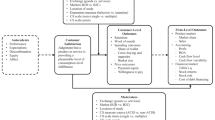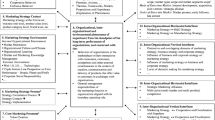Abstract
This study examines whether the choice of amortization life for purchased goodwill is predictive of the firm's post-acquisition earnings levels, given that shorter lives could lead to a dilution in earnings. Our findings support this interpretation. Further, consistent with Andrade (2001), we demonstrate a link between post-acquisition earnings changes and stock performance. These results suggest that the amortization life chosen is a reliable predictor of the success of the acquisition both in terms of earnings changes and future stock performance. These findings are relevant since the information concerning the life chosen was eliminated by the adoption of SFAS No. 142.
Similar content being viewed by others
References
Accounting Principles Board (APB), Intangible Assets. Opinion No. 17. New York, NY: APB, 1970.
Accounting Standards Board (ASB), Goodwill and Intangible Assets. Financial Reporting Standard No. 10. London, England: ASB, 1997.
Accounting Standards Committee (ASC), Accounting for Goodwill. Statements of Standard Accounting Practice No. 22. London, England: ASC, 1984.
Andrade, G., “Do Appearances Matter? The Impact of EPS Accretion and Dilution on Stock Prices. ” Working Paper, Harvard Business School, 2001.
Barron, O., D. Byard, C. Kile and E. Riedl, “High-Technology Intangibles and Analysts' Forecasts. ” Journal of Accounting Research 40, 289–320 (2002).
Barber, B. M. and J. D. Lyon, “Detecting Long-Run Abnormal Stock Returns: The Empirical Power and Specifi-cation of Test Statistics. ” Journal of Financial Economics 43, 341–372 (1997).
Beaver, W. and S. Ryan, “Biased (Conservative) and Delayed Accounting Recognition and Their Effects on the Ability of the Book-to-Market Ratio to Predict Book Return on Equity. ” Working Paper, New York University, 1997.
Bradley, M., A. Desai and E. Kim, “Synergistic Gains from Corporate Acquisitions and Their Division Between the Stockholders of Target and Acquiring Firms. ” Journal of Financial Economics (May), 3–40 (1988).
Cowan, A., “NCR accounting Tactic Could Hurt Any Merger. ” New York Times, March 22, D2 (1991).
Deng, Z. and B. Lev, “The Valuation of Acquired R&D. ” Working paper, New York University, 1998.
Duvall, L., R. Jennings, J. Robinson and R. B. Thompson, “ Can investors unravel the effects of goodwill accounting?” Accounting Horizons (June), 1–14 (1992).
Fama, E. and K. French, “Common Risk Factors in the Returns of Stocks and Bonds. ” Journal of Accounting and Economics (February), 3–56 (1993).
Financial Accounting Standards Board (FASB), Goodwill and Other Intangible Assets. Statement of Financial Accounting Standards No. 142. Norwalk, CT: FASB, 2001.
Financial Accounting Standards Board (FASB), Business Combinations. Statement of Financial Accounting Standards No. 141. Norwalk, CT: FASB, 2001.
Financial Accounting Standards Board (FASB), Business Combinations and Intangible Assets. Exposure Draft. Norwalk, CT: FASB, 1999.
Financial Accounting Standards Board (FASB), Accounting for the Impairment of Long-Lived Assets and for Long-Lived Assets to be Disposed of. Statement of Financial Accounting Standard No. 121. Norwalk, CT: FASB, 1995.
Financial Accounting Standards Board (FASB), Applicability of FASB Statement No. 2 to Business Combinations Accounted for by the Purchase Method. Financial Interpretation No. 4. Stamford, CT: FASB, 1975.
Henning, S. L., B. L. Lewis and W. H. Shaw, “Valuation of Components of Purchased Goodwill Using Market Measures. ” Journal of Accounting Research (Autumn), 375–386 (2000).
Johnson, M., R. Kasznik and K. Nelson, “The Impact of Securities Litigation Reform on the Disclosure of Forward-Looking Information by High Technology Firms. ” Journal of Accounting Research 39, 297–328 (2001).
Jennings, R., J. Robinson, R. Thompson and L. Duvall, “The Relation Between Accounting Goodwill Numbers and Equity Values. ” Journal of Business, Finance, and Accounting (June), 513–533 (1996).
Loughran, T. and A. Vijh, “Do Long-Term Shareholders Benefit from Corporate Acquisitions?” Journal of Finance 52, 1765–1790 (1997).
Lys, T. and L. Vincent, “An Analysis of Value Destruction in AT&T's Acquisition of NCR. ” Journal of Financial Economics 39, 353–378 (1995).
MacDonald, E., “FASB Mulls Stricter Rules on All-Cash Mergers, Acquisitions. ” Wall Street Journal Interactive Edition (1998).
PriceWaterhouseCoopers. 1999. Leveraged Recapitalizations.
Vincent, L., “Equity Valuation Implications of Purchase Versus Pooling Accounting. ” The Journal of Financial Statement Analysis (Summer), 5–19 (1997).
Weil, Jonathan, “Goodwill Hunting: Accounting Change May Lift Profits, but Stock Prices may not Follow Suit. ” The Wall Street Journal (January 25), C1 (2001).
Author information
Authors and Affiliations
Corresponding author
Rights and permissions
About this article
Cite this article
Henning, S.L., Shaw, W.H. Is the Selection of the Amortization Period for Goodwill a Strategic Choice?. Review of Quantitative Finance and Accounting 20, 315–333 (2003). https://doi.org/10.1023/A:1024043316292
Issue Date:
DOI: https://doi.org/10.1023/A:1024043316292




